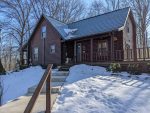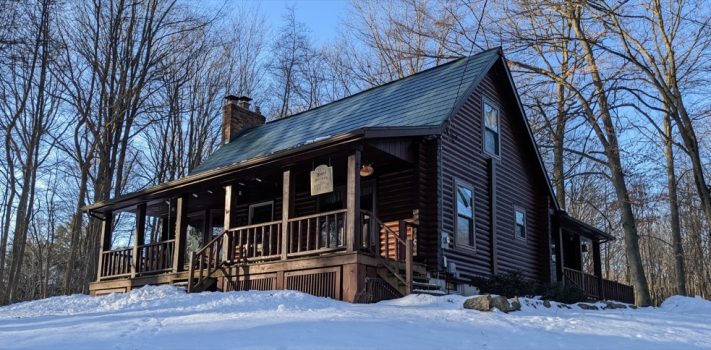More than eight years ago now, my wife and I fled suburbia for a log home in the woods. A log home in the woods sounds very idyllic, but the reality may not be as charming as the concept. Based on our limited experience, I have some advice for people who may be considering a similar flight.
Not Necessarily a Log Home
If you own enough timber and have enough time to fell, prepare and season the timber from your own property, a log home may be a good option. But if you are buying the materials from someone else, there may be better options.
Solid log walls simply require more board feet of wood than other forms of construction. Since wood is expensive, a home built with solid log walls may be more expensive than other alternatives.
Solid log walls also have a lower R-value than insulated walls of similar thickness. This may make it more difficult to heat a log home than other alternatives.
Log homes require a great deal of maintenance. In succession, I stain one of the outside walls of my home each year, so that each of the walls is stained once every four years. That is quite a bit more labor-intensive than the maintenance required for most other types of siding.
My wife and I chose a log home for aesthetic reasons. We wanted to provide an attractive setting to host pastors and missionaries who needed a quiet place to rest. Based on our experience with solid log walls, I would choose cement faux-log siding instead if I had the option. It is virtually maintenance-free, has a longer life span, allows for a wall with a higher R-value, and is more fire-resistant than solid log walls.
Bats in the Belfry
Another drawback of log homes is the manner in which the soffits intersect with the irregularities of the log walls. These irregularities make it easier for wildlife to gain access to the structure. In our case, the most challenging wildlife to gain access was bats.
The various species of bats in the United States are protected. This means that we could not just hire an exterminator to kill the bats, nor could we go up into the attic and kill the bats ourselves. We needed to hire a “wildlife exclusion specialist”, who at the proper time of year would seal up most of the tiny openings allowing bats access to our attic, and who would then place “bat valves” at the few most trafficked openings to allow the bats to leave but not to reenter the attic.
Most wildlife exclusion specialists would not even provide us with a quote due to the fact that we live in a log home. The first wildlife exclusion specialist who attempted to exclude our bats took our money, failed, and then promptly stopped accepting our phone calls.
The second wildlife exclusion specialist who attempted to exclude our bats also took our money, partially failed, and then refused to perform an inspection to confirm the partial failure until after the warrantee period was over. When the warrantee period was over, he was happy to perform additional work at full cost.
One good thing about bats is that they eat mosquitoes. We live in a swampy area, so anything that eats mosquitoes can’t be all bad. One bad thing about bats is that they stink. There is nothing quite like the smell of urine soaked guano emanating from the attic on a steamy summer day. My wife in particular finds the odor intolerable.
Living in the woods, we have frequent encounters with other forms of wildlife as well: mice, snakes, squirrels, deer, rabbits, turkeys and many other kinds of birds, etc. Some of these encounters are more welcome than others. If you flee to the wilds, you need to be aware that being closer to nature means that nature is closer to you.
Not in Winter
In Matthew 24:30, Jesus says that the Judeans should pray that the flight associated with the abomination of desolation will not take place in winter. This is good advice for those who flee suburbia, both literally and metaphorically.
It is good advice metaphorically in the sense that it is best to flee when conditions are good. If you are thinking about fleeing suburbia, you may want to think about doing so sooner, while conditions are better, rather than later, when they are likely to be worse.
It is good advice literally in the sense that it is hard to move from the city to the country during the winter. We purchased our home in January. It had been a foreclosure, and needed a lot of work. Among other damage, there had been a chimney fire, and the chimney liner was cracked, so we couldn’t use the wood stove at first. We didn’t have any firewood at first anyway, so to some extent that was an academic issue. We were forced to start out by burning a lot of propane to keep the house warm. That was very expensive.
We also needed to quickly find a way to clear the driveway of snow. In suburbia, I could clear my modest driveway with a shovel. Out in the woods, where my driveway is more than 300 yards long, I cannot. I needed to make some immediate decisions in areas in which I had little or no experience. I had very little time to research the best options. Fortunately, I stumbled upon a slightly battered but highly serviceable and reasonably priced 1974 John Deere 110 lawn and garden tractor with a snow blower attachment. This combination has met our needs very well. But it was a bit stressful to have to find something on such short notice, and it was only God’s grace that allowed us to find such a good solution so quickly. All other things being equal, it is best not to put God’s grace to a foolish test.
A Steel Roof
When we bought our log home, the roof was in horrible shape. We replaced it in the spring when the weather allowed with a steel roof. I have been very happy with that decision.
When I say “steel roof”, I am not talking about agricultural steel. I am talking about residential/commercial grade steel. It looks nice, it is extremely durable, it has a long life expectancy, it is fire resistant, and the snow slides off on its own.
The fact that the snow slides off on its own means you do have to be aware of where that snow will land when it slides off and make appropriate allowances. For example, we have a steel roof on our church building as well. We have to rope off one of the sidewalks that runs near the building during the winter to keep people from being buried under “roofalanches”.
No Valleys
 Although I love our steel roof in general, there are two valleys in the roof that create problems. Snow collects there, melts and re-freezes, and creates ice dams. As a result, I need to rake the snow out of those valleys pretty much every time it snows to prevent future problems. In an ideal world, I would live in a home with a steel roof that has no valleys.
Although I love our steel roof in general, there are two valleys in the roof that create problems. Snow collects there, melts and re-freezes, and creates ice dams. As a result, I need to rake the snow out of those valleys pretty much every time it snows to prevent future problems. In an ideal world, I would live in a home with a steel roof that has no valleys.
You Cannot Control What You Do Not Own
When my wife and I moved into our home, we assumed that no one would ever develop the swamp land to our north. We were wrong. Someone jumped through the necessary hoops with the State Department of Environmental Quality to get the necessary permissions to develop the land. They then went to a huge expense to haul in a lot of fill dirt. I estimate that my neighbors driveway cost more than my entire home.
We now have a neighbor to our north that we can see when the leaves fall off the trees in autumn. Our new neighbors are great people, and we are glad to know them. But we have lost some of the sense of solitude and privacy that we enjoyed when we first moved here.
If I had to do it all over again, I think I would have at least made an offer on that parcel of land when it went on the market rather than just assuming that there was no way it could possibly be developed.
Conclusions
I am very happy to have a home in the woods, but I am not so happy that it is a log home. I am glad that we moved here, but it was hard doing so during the winter. I love our steel roof, but I wish that it did not have any valleys. I like our neighbors, but I wish they lived a little farther away.
If you are thinking about fleeing suburbia as well, I hope that this information is helpful to you.
Disclaimer
I did not receive any financial or other inducements to mention any vendor, product, or service in this article.










